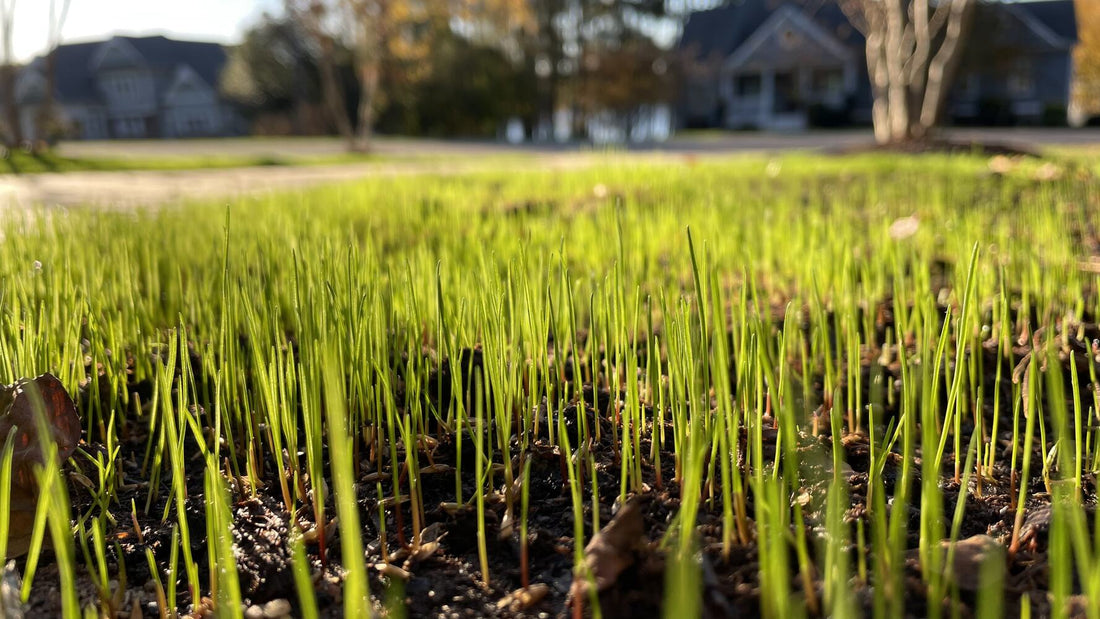The germination of grass seed is a fascinating and vital process that transforms tiny seeds into a lush, green lawn.
If you're wondering about the germination of grass seed, you've come to the right place. Understanding this process can help you achieve a beautiful and sustainable lawn.
In this article, we'll dive deeper into grass seed germination, exploring everything from the initial stages of seed preparation to the optimal conditions needed for successful growth. We'll cover essential topics such as pre-germination techniques, planting methods, and proper care for your grass seedlings.
So, if you're ready to learn the secrets behind successful grass seed germination and take your lawn to the next level, continue reading.
What this article covers:- What Is Germination?
- Benefits of Pre-Germinating Grass Seed
- Pre-Germinating Your Grass Seed
- How to Plant Grass Seed
- How to Care for Grass Seedlings
What Is Germination?
Germination is the process by which a seed develops into a new plant. It involves several critical steps: imbibition (water absorption), activation of enzymes, and growth of the embryo.
Imbibition is the initial phase where the seed absorbs water, causing it to swell and soften. This water absorption triggers the activation of enzymes that break down stored food resources within the seed, providing energy for growth.
The final stage is the growth of the embryo, where the radicle (the embryonic root) emerges, followed by the shoot.
As lawn care experts, we know that ensuring optimal soil conditions such as appropriate moisture, temperature, and nutrition levels during germination is crucial for a healthy lawn.

Benefits of Pre-Germinating Grass Seed
Pre-germinating grass seed can significantly improve the success rate of your lawn. Our findings show that pre-germinated seeds sprout faster and more uniformly. This method is especially useful if you're facing challenging growing conditions.
Pre-germinated seeds establish roots days earlier than non-germinated seeds, which helps them fix into the soil more securely and prevents them from being washed away.
This technique also saves water since it requires less frequent watering of the entire lawn.
However, we only would recommend this method for small areas as it is difficult to pre-germinate seed in masses.
Pre-Germinating Your Grass Seed
To pre-germinate your grass seed, focus on the following factors:
- Moisture: Seeds need consistent moisture to germinate. Place them in a damp paper towel, and keep them moist but not soaked. Consistent moisture signals the seeds that conditions are favorable for growth, allowing them to begin the germination process.
- Light: While grass seeds don't require light to germinate, they will need it once they sprout. Ensure they are in a bright spot after pre-germination to support healthy growth. Adequate light is crucial for the seedlings to develop strong and vibrant blades of grass.
- Oxygen: Seeds need oxygen to breathe. Avoid water logging by keeping the seeds in a well-ventilated area. Proper oxygen levels are essential for the metabolic processes that drive germination and seedling development.
- Temperature: Maintain a warm temperature between 65-75°F for optimal germination. Based on our observations, this temperature range encourages the best growth. Proper temperature ensures the enzymatic activities necessary for germination are at their peak efficiency.
By focusing on these factors, you can enhance the success rate of your pre-germinated grass seed and achieve a lush, healthy lawn.

How to Plant Grass Seed
Now that it's time to plant your grass seed. Here's how:
- Prepare the Soil: Loosen the top 2-3 inches of soil and remove debris. This step ensures that the soil is aerated and free from obstructions, creating an ideal environment for seedling roots to penetrate and grow. There should not be any debris, rocks, or weeds present.
- Sow the Seeds: Spread the grass seed evenly across the prepared soil. For larger areas, using a lawn spreader can help achieve a uniform distribution. Even coverage is essential for a consistent and lush lawn. Typical grass seed rates include:
- New Lawn Installation: 10 lbs per 1,000 sqft
- Overseeding: 5 lbs per 1,000 sqft
- Cover Lightly: Cover the seeds with a thin layer of seed-aide or peatmoss to protect them from being washed away or eaten by birds. A light covering also helps retain moisture, which is crucial for germination.
- Water Gently: Keep the soil consistently moist but not waterlogged. Water gently to avoid disturbing the seeds. Consistent moisture is key to successful germination, ensuring that the seeds remain hydrated and continue to grow. Do not let the seed try out.

How to Care for Grass Seedlings
Proper care during the early stages is crucial. Here's our advice on grass care:
- Watering: Water frequently to keep the soil moist. Consistent moisture helps grass seedlings establish strong roots and promotes healthy growth.
- Fertilizing: You may be wondering “How much fertilizer for lawn?”. We recommend starting with a light application of a balanced lawn fertilizer, such as our 15-20-10 Starter Fertilizer This fertilizer provides essential nutrients to support the seedlings' growth. Remember, using too much fertilizer or applying it incorrectly can harm your new grass. If you're wondering, “will fertilizer kill new grass?”—yes, if not used properly.
- Weed Control: Hold off on using any weed control products until the new seedlings have matured and the lawn has been mowed at least 2-3 times.
If you're looking for premium grass seed, look no further than our grass seed collection. Whether you're interested in our Crown Jewel Elite Tall Fescue Grass Seed or our HighGreen Tall Fescue Grass Seed, our collection has the perfect grass seed for you.
Conclusion
Understanding the germination of grass seed and providing the right conditions are key to growing a lush lawn.
By following these steps, you can ensure successful germination and vibrant growth. Lawn Synergy is here to support you every step of the way with expert advice and high-quality products.
If you want to learn more, why not check out these articles below:
- How Often to Fertilize Lawn
- How Does Grass Grow
- How Long Does Lawn Fertilizer Take to Work
- Weed and Feed or Grass Seed First
- Best Fertilizer for Yellow Grass
- Best Fertilizer for Bahia Grass
- Best Fertilizer for Tall Fescue Grass
- Best Weed and Feed for St. Augustine Grass
- Best Fertilizer for Centipede Grass in South Carolina
- Best New Lawn Fertilizer
- Best Organic Fertilizer for Lawn
- Best Weed and Feed for Lawns
- Best Lawn Fertilizer for Texas
- Best Lawn Fertilizer for Florida
- Best Fertilizer for Clay Soil Lawn

